Wrist Analysis
A computer kinematic assessment is performed for wrist flexion/extension,
ulnar/radial deviation and supination/pronation. The Examinee is asked to
perform each maneuver 8-10 repetitions to full range and as quickly as possible.
The events are video taped in a precisely calibrated field for computer
analysis. Each event is analyzed for total dynamic range of motion and peak
velocity quantity and quality. Consistency of results [coefficient of variation]
is considered for determining Examinee effort. After a thorough discussion of
expectations, and agreement of understanding by the Examinee, the Examinee is
asked to perform the movement events.
Preparation
- APAS - CAPDV;
- Chair
- DV Camcorder with firewire connection to the data collection computer;
- Calibration frame.
 |
 |
| Large frame |
Small frame |
Room Setup
- Clear the working area of any obstructions that may block the camera
views.
- Place a reflective marker (fixed point) anywhere in the view where the
Examinee or Assistant/Examiner will not block it during motion.
Camera Setup
- Look through the viewfinder, make sure you can see the entire frame - plus
enough space surrounding frame - to film the entire sequence.
- Set focus to auto focus then back to manual focus.
- Set shutter speed at 1/250 s.
[ Last revised on 01/12/2004 ]
| |
Examples |
|
Description |
| Markers |
 |
Three markers |
| # |
Left |
Right |
Description |
| 1. |
L.FOREARM |
R.FOREARM |
Forearm in line with ulnar styloid and the 5th metacarpal when wrist
is in the neutral position |
| 2. |
L.WRIST |
R.WRIST |
Ulnar styloid |
| 3. |
L.MP5 |
R.MP5 |
Ulnar aspect of the 5th metacarpal joint |
|
| Calibration |
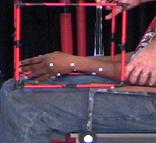 |
Small calibration cube |
Check computer screen and recheck the position of the cube, the cameras, and
the fixed point.
Capture data for 0.5 s.
|
| Protocol |
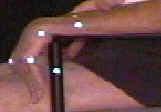 |
 |
Make sure Examinee is in center of view field. The Examinee must be aligned in the
field of the front portion of the calibration cube. If acceptable, proceed with
data collection.
Capture data for 25 s.
|
| |
Cervical Flexion |
Cervical Extension |
[ View typical results ] |
| |
Examples |
|
Description |
| Markers |
 |
Three markers |
| # |
Left |
Right |
Description |
| 1. |
L.FOREARM |
R.FOREARM |
Forearm in line with the 3rd MP joint head and the midline of the
wrist. |
| 2. |
L.WRIST |
R.WRIST |
Midline of the wrist |
| 3. |
L.MP3 |
R.MP3 |
3rd MP joint head |
|
| Calibration |
 |
Small calibration cube |
Check computer screen and recheck the position of the cube, the cameras, and
the fixed point.
Capture data for 0.5 s.
|
| Protocol |
 |
 |
Make sure Examinee is in center of view field. The Examinee must be aligned in the
field of the front portion of the calibration cube. If acceptable, proceed with
data collection.
Capture data for 25 s.
|
| |
Cervical Flexion |
Cervical Extension |
[ View typical results ] |
| |
Examples |
|
Description |
| Markers |
 |
Two markers |
| # |
Left |
Right |
Description |
| 1. |
L.RADIAL |
R.RADIAL |
Wand - radial marker |
| 2. |
L.ULNAR |
R.ULNAR |
Wand - ulnar marker |
|
| Calibration |
 |
Small calibration cube |
Check computer screen and recheck the position of the cube, the cameras, and
the fixed point.
Capture data for 0.5 s.
|
| Protocol |
 |
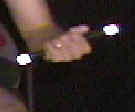 |
Make sure Examinee is in center of view field. The Examinee must be aligned in the
field of the front portion of the calibration cube. If acceptable, proceed with
data collection.
Capture data for 25 s.
|
| |
XYZ |
XUZ |
[ View typical results ] |
Wrist Flexion/Extension
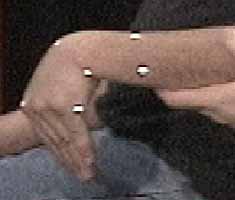
|
|
Picture 22:
LeftWrist Flexion -
|
|
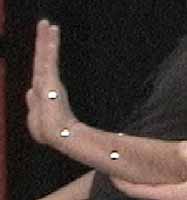
|
|
Picture 23:
LeftWrist Extension -
|
|
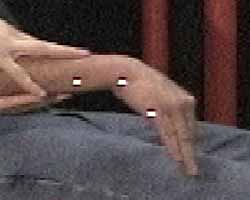
|
|
Picture 24:
RightWrist Flexion -
|
|

|
|
Picture 25:
RightWrist Extension -
|
|
|
Chart 8:
Wrist Flexion/Extension
|
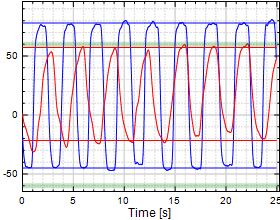
|
|
|
Table 8:
Wrist Flexion/Extension (F/E)
|
|
|
|
Wrist Ulnar/Radial Deviation
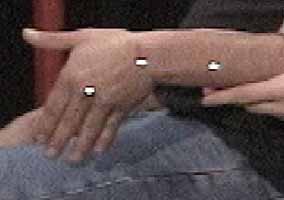
|
|
Picture 26:
LeftWrist Ulnar Deviation -
|
|
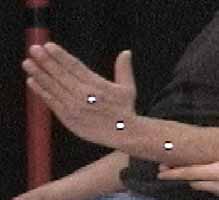
|
|
Picture 27:
LeftWrist Radial Deviation -
|
|
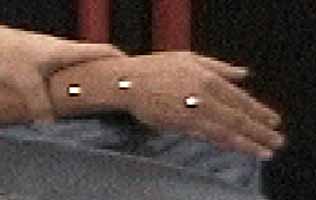
|
|
Picture 28:
RightWrist Ulnar Deviation -
|
|
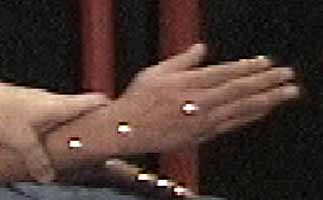
|
|
Picture 29:
RightWrist Radial Deviation -
|
|
|
Chart 9:
Wrist Ulnar/Radial Deviation
|
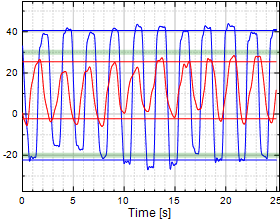
|
|
|
Table 9:
Wrist Ulnar/Radial Deviation (U/R)
|
|
|
|
Forearm Supination/Pronation
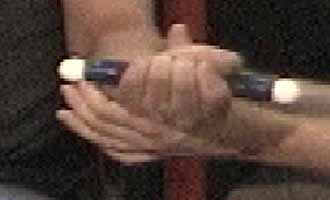
|
|
Picture 30:
LeftForearm Supination -
|
|
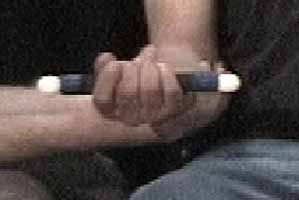
|
|
Picture 31:
RightForearm Supination -
|
|
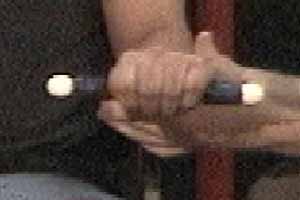
|
|
Picture 32:
LeftForearm Pronation -
|
|
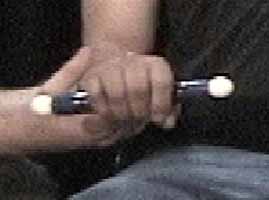
|
|
Picture 33:
RightForearm Pronation -
|
|
|
Chart 10:
Forearm Supination/Pronation
|
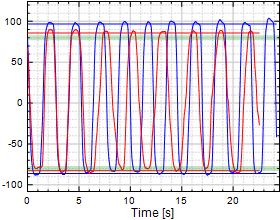
|
|
|
Table 10:
Forearm Supination/Pronation (S/P)
|
|
|
|
|
Summary 7:
Kinematic Wrist Assessment
|
|
|
- Number of tests where Examinee performed subnormal:
4
of
12
- Number of tests where Examinee performed asymmetrically (one side worse than the other):
6
of
12
- Number of tests where Examinee performed worse on Left Side than on Right Side:
0
of
6
- Number of tests where Examinee performed worse on Right Side than on Left Side:
6
of
6
Significant Findings Kinematic Wrist Assessment:
See also